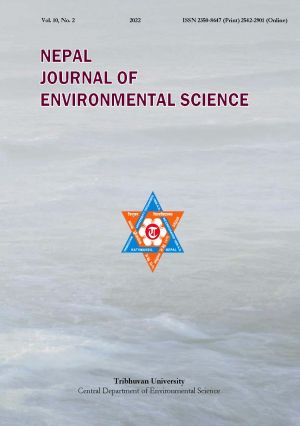Photocatalytic decomposition of textile dyeing effluents using TiO2, ZnO, and Fe2O3 catalysts
DOI:
https://doi.org/10.3126/njes.v10i2.46704Keywords:
Degradation, effluent, photocatalyst, textile dye, treatmentAbstract
Textile dyeing industries are facing the challenge of environmental sustainability due to the discharge of large volumes of textile dyeing effluents containing residual reactive dyes and chemicals. Hence, it is imperative to treat the discharged effluents before releasing them into the environment. The study aimed to degrade textile dyeing effluent using some selected catalysts. The study collected some effluent samples from the Bangladesh Small and Cottage Industries Corporation (BICIC) of Rajshahi, and were subjected to photocatalytic decomposition using three catalysts such as TiO2, ZnO, and Fe2O3. It considered several operational parameters, including irradiation time, catalyst concentration, pH, and dose of the oxidizing agent for optimizing the color removal efficiency. Besides, the kinetics and the mineralization of the photocatalytic decomposition reactions were examined. The study results showed that the maximum 81.6% decomposition was achieved using ZnO catalyst at the optimized conditions. It also showed that TOC and COD were reduced by about 97.9% and 43.53%, respectively. Kinetics study of the degradation process of the effluents showed pseudo-first-order reactions indicating the potentiality of the catalysts. The study observed that the ZnO is suitable for photocatalytic degradation in the textile dye effluents treatment.
Downloads
Downloads
Published
How to Cite
Issue
Section
License
Copyright (c) 2022 Central Department of Environmental Science, Tribhuvan University

This work is licensed under a Creative Commons Attribution-NonCommercial 4.0 International License.
This license enables reusers to distribute, remix, adapt, and build upon the material in any medium or format for noncommercial purposes only, and only so long as attribution is given to the creator.

